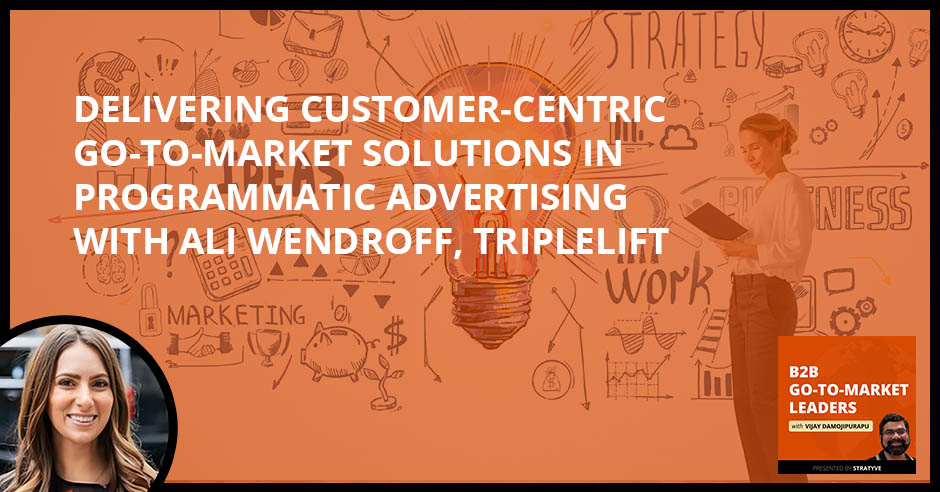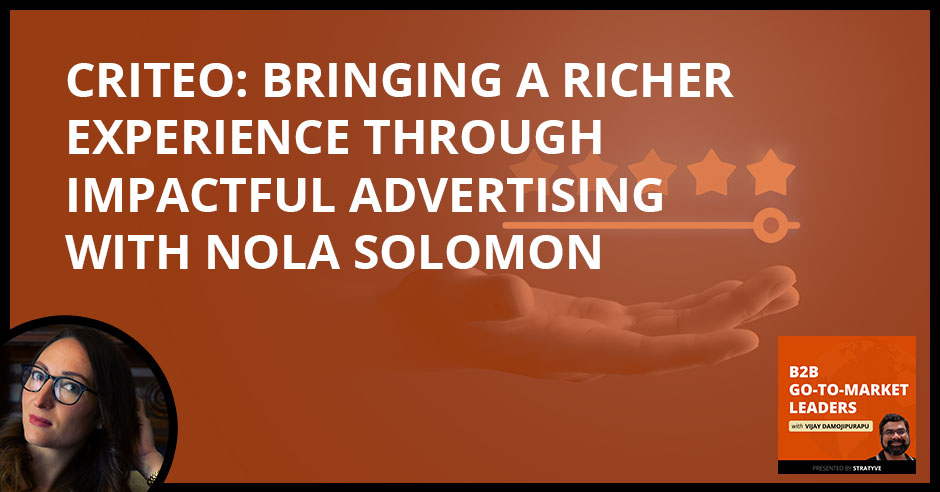

Our guest today defines go-to-market as a strategic iterative process of delivering a solution based on an opportunity in the market. To her, everything comes down to positioning. It’s all about understanding the goals of your clients so your product suits their needs. This is how Ali Wendroff approaches go-to-market strategy in her position as Senior Director of Global Engagement at TripleLift. In this conversation, she shares her journey from her first job in an ad tech company to her present leadership position in a global leader in the programmatic industry. Join in and learn about the ins and outs of go-to-market strategy in this fast-paced core industry!
—
Listen to the podcast here
Delivering Customer-Centric Go-To-Market Solutions In Programmatic Advertising With Ali Wendroff, TripleLift
In this episode, I have with me Ali Wendroff, who is the Senior Director of Global Engagement at TripleLift. I am excited to have you on the show.
No worries. Thank you so much. I’m excited to be here.
This is what I always start off the show with, and this is a very intriguing and interesting question. It takes the conversation in a lot of directions with the speakers and even the readers enjoy. Ali, how do you define go-to-market?
I put a lot of thought into this, but I would define go-to-market as a strategic iterative process of delivering a solution that’s based on a need or an opportunity that has presented itself in the market. I think what’s most important in terms of the go-to-market process is positioning. It’s all about your audience. It’s fully understanding the goals of your clients to ensure that the product or solution suits their needs and identified gaps.
I think it’s far from a one-size-fits-all approach, and it’s rather entirely about the voice of the customer, which varies even within an organization with whom you might be engaging with. If you can’t answer the why, why it matters, why your clients should care, why it solves a problem, why should they want it, and why it speaks their language not yours, then I don’t think you have done enough legwork or homework to fulfill and validate the journey that you are planning to take them on.
I love the fact that you are emphasizing so much the customer and the whys of the customer. This is something that I keep pushing both at the places where I worked as well as with the clients that I consult with, which is the whys of the customer. Simple things like taking the time to go and interview the customer. This is the easy trick, and unfortunately, a lot of folks in marketing and sales miss out, especially in marketing and maybe even product.
When you interview the customer and ask questions like, “What are the objections like or what are your fears when you were looking to buy a product or service?” Another question can be, “How would you explain and define or talk about our product and services to appear in your industry?” Those are something we can use in the copy as well.
Though you might be the company bringing a product to market, it’s not about you. It’s about whom you are bringing it to and making sure that you understand them and speak their language in order for it to make it out of the go-to-market funnel and hit, in my opinion, with the most intentional impact.
Though you might be the company bringing a product to market, it's not about you. It's about who you're bringing it to. Click To TweetI love the way how this show got started. A great description and opening. Why don’t you tell a bit about yourself, your journey, both personal and more professional, and what made you arrive at where you are now?
I’m a born and raised native New Yorker. I went to the University of Maryland, and I was a Psychology major. I love people and I love networking and relationships. I was pursuing the path toward child psychology and relationship based. I graduated and what we like to say is I was birthed into programmatic. I remember my first job and I showed up in a suit. I still won’t live that down to this day. It was a site for sore eyes walking into a very casual ad tech company and I was fully professional. As they always say, you can never be overdressed.
I started actually at an ESP-ish-like place CPXi, where I was fresh out of college. I was ready to learn a new industry. I was surrounded by folks that seemed to be hustling and I worked for three account executives covering basically all of North America learning the weeds and getting my feet wet. Following that, I made my way over to PubMatic where I worked with key leaders who all through the years remained mentors and friends. I think this was where I feel I was seen. I learned to grow wings here.
I was given a runway with the sky seemingly as the limit. I came in as an account executive, more junior, and a good portion of the team was out either on maternity or for other reasons. I ended up inheriting a massive book of business very early on and was empowered by those around me to learn, embrace, and succeed.
There were a lot of diverse skillsets teachers. We were like a family back then and I was on the DSP side managing roughly 25% of the entirety of the DSP business. Here, I also learned the balance between the publisher side and the ad solutions team. I started to spearhead the PMP growth and what I call my PMP love story, but the joy of being at the epicenter.
What is PMP?
It’s the Private Marketplace. It is a form of the transaction by the deal, which back then was only hitting the forefront versus where it’s now, which is booming but where I was at the time, I was still sitting on the DSP ad solution side and being able to develop these PMPs, you had to sit in between supply and demand. This is where I think my love of being at the epicenter of that intersection began. From there, I moved to Kargo, a mobile-first SSP at the time that was largely managed when I got there. I was brought there to build their programmatic stack on the business development team.
Here, I got to know the agency and the direct sales teams. I worked alongside their business as a consultant almost and what have you because the goal was to start to transition some managed brands, agencies, and advertisers to programmatic, which was quite a unique experience. It’s hard to get a managed team to want to move dollars to programmatics. That was a learning experience and a challenge, but ultimately, we were able to scale the programmatic business nearly 100% and integrate the programmatic team into the sales org.
Kargo at the time was really a dominant PMP business as well. I was still staying in the line of the private marketplace deals-based transactions. From here, I was brought to TripleLift, and I was brought on to the supply side as the PMP market maker. This was a huge moment for me. I wanted the role so badly. I knew it would be a challenge. I have also never been on supply directly. I was so curious as to how to translate all of my buy side work and working with advertisers and the demand side into a supply strategy.
I spent over a year or so in this position and I wore a bunch of different hats, but I drove the majority of the success for TripleLift PMPs by hustling between supply and demand to build that market and drive revenue. Also, developing custom go-to-market plans for each publisher based on their business models that would suit their commercial teams. You probably are seeing a little bit of a theme here. After some time the epicenter was calling me back and I love TripleLift.
I realized that the buy side was tugging at me and my current boss now, I’m Sonja Kristiansen, the Chief Business Officer of TripleLift, floated the idea of this DSP engagement team in my head. I had approached her to think about what my next path within the company would be, and bells and whistles went off. Now, there was no roadmap. It was, “Here’s what we are thinking, build it. Build something completely new.” I enjoy living in ambiguity. At the time, I had spent and now I moved over and ultimately developed what is now the DSP Global Engagement team. It was born back then and a few years later, it’s a global team of ten supporting big tech teams and additional service model DSPs as consultants.
I love the way you are from an individual contributor in the sales and then moved from demand to supply to being in the epicenter of the marketplace. I love the fact that your psychology background played a big role in all of these things. Would you call that your magic skill or is that the powerful skill that you bring to the table?
What everyone likes to think is so automated, but I always would say I’m old school. What I have learned along the way is relationship-building and being respectful of those that you work with and that a team of teams approaches and collaborating takes a village. I think from my early days in psychology, I love people. I’m very curious. I enjoy learning, asking a lot of questions, and listening to some of the pain points, the gaps, or successes and understanding what’s behind that.
I think that it empowered me to lean on experts around me, and also understand the core functionality of go-to-market, which is what are the needs of the clients? What do they need and how can I help deliver solutions in a way that best suits them, which therefore transactionally would suit us as well as tier-one service partners?

You also mentioned, and this word kept coming up in your overview, which is programmatic. For those of us who are not in the industry, can you give us a quick primer? What is programmatic?
This is always a tough one of what you are going to get. I like to think of programmatic as all of the tech and behind-the-scenes of powering online advertising. To boil an ocean into a really simple phrase, all of the online ads that you might engage with on your phones, on your tablets, or any form of media at this point or channels out of home. In order to get that and deliver that experience to you, the programmatic industry is what powers that. Also, the tech that is involved in doing that and making sure that the right ads are delivered at the right time in more of an automated kind of behind-the-scenes way that you wouldn’t think as second nature shall we say. It’s all the behind-the-scenes work of what it takes to put an ad in front of you as a consumer.
For me, when I’m a marketer or when I’m trying to build an additional marketing campaign, in my mind, I’m an individual and I go directly to LinkedIn or Google or Facebook versus your clients. What you are streamlining is not for this one individual who’s looking for maybe 5 or 10 ads, but we are looking for thousands or even millions and millions of budgets as well.
There is certainly a one-to-one type of relationship between programmatic and reaching those key consumers, but there are larger audiences, one to many. I think that we see that a lot in how media gets transacted these days as well with so many different buying methodologies and even the evolution of how to reach consumers appropriately, how to do it right, but also how to make sure it’s sending the right message from brands to the right people.
I know we can go deeper into this one topic, programmatic, especially with everything that’s going on in the search world, plus the ChatGPT and AI and everything that’s happening. Search is going to evolve for sure, but that’s a huge topic in itself. If you have an opinion, we can spend 5 to 10 seconds or whatever.
I think this is an interesting time for the tech industry. I would say it’s the first time in all of my years in the industry that I think I could say I’m even overwhelmed. It’s so fair to be self-aware. There are so many new players and new media streams. You have retail media that’s now surpassing CTV and new narratives coming out and search and then the deprecation of the cookie, and what have you.
However, what it comes down to is where I was and where things started. You were expected to learn everything and be the expert on all things. I think where we are now, it’s about not only understanding how each of these different modes of media or channels or programs impact your business but also, how are consumers interacting with each of these. Are they overwhelmed?
What does it mean to have a package that hits on all the points of what a consumer is looking for and how can we as programmatic experts or what have you simplify this? How can we digest this when we could barely digest it ourselves? I think it’s so important to stick to the core competencies and principles of what our audiences and what brands are trying to do to reach those consumers and understand those pathways in order to not boil the ocean of the Lumascape these days. Also, make it easier, more seamless, and more efficient for our clients.
This is a huge overhaul and upheaval that’s happening in the industry. Many touchpoints are affecting so many areas across the business models of different tech companies. Not only that, for me as a marketer, I’m challenged to come up with the content and what channels to use for my content now.
We are seeing that, and that’s something that is super important for my team but I always say being nimble. Be flexible. Everyone always wants the same outcome, which is whatever success means to you but the journey to getting there is much more important because you can’t be afraid of delivering a solution that might fail. You can’t be afraid of having something underperform. Instead, you have to do the legwork to understand the goals and what work.
You have to be able to invent and reinvent your own wheel, your own narratives because they are going to change because the ecosystem is changing. Also, new partners are being introduced and it’s exciting, but it’s a consistent hustle where being able to balance that is so important with clear messaging, clarity of goals, and defining the needs in a way that doesn’t feel like they could go in 800 different directions.
With that as a background and context, what I always ask and this will be useful and enlightening for the readers is if you can share a go-to-market success story and a go-to-market failure story. You can pick your choice.
I would say a go-to-market success story is about a few years ago when I launched this team, it was about a year in and social platforms was are booming between TikTok, Facebook, Instagram, Pinterest, and what have you. There are many others. What we were looking at is native at the time. TripleLift is naturally an omnichannel SSP. Native was our core business and we have since evolved it to CTV, OLV, you name it.
Back then, we were working with our key DSP partners to understand how to make natives seem a lot easier. When you say what is native advertising, even when I joined TripleLift, I was like, “What is native?” What am I doing? For people that aren’t familiar with it, it’s ads that match the look and feel of the publisher’s page. That’s what native means to us. However, when you don’t know what it is, you think that there are so many different creatives and overhauls that have to happen.
Instead, what I started to see is the majority of the brands have a social strategy in the market. They have social assets. They are working to generate greater followings on those platforms and they should keep doing that. What I did build was social to native extension. Repurpose your social assets and extend them to native and the programmatic ecosystem.
What this did was it made native easy. It made it efficient. It made it seamless so that anyone in our DSP platform that had buyers that were transacting on social and were working with various teams within an agency could very easily say, “You don’t need to reinvent assets or go through a new creative process.” Instead, here are spec sheets specific to each DSP as to how to take that social video and run native video. Run instream or how to take that standard unit that runs on Facebook or Instagram like a more standard asset and run a beautiful native image ad seamlessly.
The goals prove to be far more successful in a programmatic space than they were in social. Naturally, there are different goals. It’s not discrediting any platforms, but realizing that brands could not reinvent their wheel but extend and grow their share of voice across the programmatic ecosystems and their consumers. It balanced their social strategy well. This was where we got native on the map of an evergreen strategy. The way in which people look at social is the way in which they should look at native and build that without having to do anything all too different than they were already doing.

This was a big success across our book of business. A lot of our key partners looked at us as thought leaders. What was the most impactful for me was I felt like I was able to educate our consumers and our clients. Our clients are not clients that most view as clients. Our clients are DSP internal account teams. Some might say they are a little bit forgotten along the way or the activators, but being able to educate them about what they could do and how they can extend their partnership reach with existing buyers. We saw a tremendous increase as it relates to native adoption, our partnership with each of our key partners, and that they felt supported in this narrative too.
Going back to the early part of the discussion, which is keeping the voice of the customer and understanding that. Also, educating them and bringing them along in the journey. I can see all of those elements or ingredients being played out in this story. Kudos to you.
At least they could say, “I’m tried and true.” I know you had asked about a failure. Along the way, it’s so important to have failures. It’s so important to realize what doesn’t work. I would say that the go-to-market failure that I would address here is when I was back in my first role at TripleLift as the Private Marketplace Market Maker. I tried to develop what I called a prestige PMP package.
The idea here was how can I scale one-to-one PMP to one to many packages for premium publishers. Back then a lot of asks were, “How can I get more premium publishers in one deal with a fixed rate?” I had built this idea of, “Let’s package them together by vertical.” This wasn’t necessarily about performance. This was much more about branding and reach because measuring a lot of publishers at the same time is harder to do back then.
I built these tent-pole and vertical packages. I was so excited about it. I felt that as a one-woman show driving one-to-one PMPs one by one was not going to scale eventually. This I thought was great. This is going to be an easier way to do this. It went to the market and I will never forget it. I was troubleshooting all night with one of our previous co-founders like, “Why isn’t this working” Some publisher is working and one is not. We have the highest win rates but I realized at that moment that I didn’t do enough homework.
It lacked the depth and the research to understand what wrappers are these publishers on and what are agreements we have in place. How do they operate their marketplaces? How is our tech built to support this on behalf of buyers that have different buying strategies? My idea was a little shortsighted and I realized then that I need to take a step back. I’m not done with them yet. They will come back around, but instead, I transitioned it into a commercial piece of, “Tent-poles and vertical alignment for publishers is appealing to our buyers.”
It was the mechanisms of the way in which we were building these deals that I didn’t do enough exploration on. It taught me to say, “What worked,” which was buyers were interested. It was the execution piece that didn’t play out. I shifted that in terms of working with our product marketing team to make it more of a sales enablement play and change the structure of how these deals are constructed.
I will tell you that I’m still not done with them and I hope to come back around to reinvent that vision but I learned from it. You got to go deeper. You have to ask more questions, “What did I miss?” It’s still on my mind and I hope to solve it one day, but at least we were able to become a much more impactful player in the curated deal space in audiences, tent-poles, and vertical but I have yet to crack that code and I will have to go back to it.
I’m sure you must be getting called out for that persistency of yours.
I am persistent. I will give it that. I’m willing to go the distance. I don’t take no very well, but not because I don’t like a no, but because I think a no is one step closer to a yes. Even if I have to burn it down and rebuild it, I am all about finding it. If there’s a will, there’s a way.
This is where I can see your sales mindset coming, which is no, is fine, but no, doesn’t mean never. It just means not right now.
I will come back around and let you know when it works.
It was a great story there. I love the way where you never ever gave up. Again, bringing your sales mindset and thinking to the fore here. Also, something that caught my attention, and again, it goes back to how we define go-to-market, which is yes, you are in a hurry to get that product out. You could see that, but at the same time, you have admitted it after the fact. It happens to all of us, which is we are in a rush and get it done more but then in hindsight, we realized that we missed a critical research piece, especially on sales enablement or how to package or how to portion it for our customers.
Even back then, I was so used to running like a chicken with my head cut off a little bit, but in a singular mindset that when you do bring something to market, there are so many different skillsets and experts that are involved between the product and the deals team for that specific initiative that didn’t go as planned. It taught me to go deeper. Go the distance because you might not have all the answers, but bare minimum, scoping things out and really making sure you do put the time in. Legwork to me is 90% plus of a successful go-to-market.
Legwork is 90% plus of a successful go-to-market. Click To TweetWith that, as the context and backdrop, how would you define TripleLift’s go-to-market strategy specifically you and your team’s role and function within that?
I will speak to TripleLift first. TripleLift is an omnichannel essential marketplace for better ads that can drive better results. Ultimately, we are an organization that has always cared deeply about consumer experience, client trust, and efficiency. We develop products based on solutions that clients, whether it be advertisers or publishers are looking for or a market need. We deliver them with education and end-to-end support across native display video and CTV.
What it takes for us to typically bring something to market are four phases. There’s the pre-alpha, which is about discovery, understanding competitors, and what the minimum viable product would be to capture market opportunity. It’s a lot of gathering feedback and research inputs. From there, it moves to alpha, which is when product and engineering build the pipes and want to test and test again and verify. Also, understand what’s going on in the environment as it relates to performance, reporting, and basic functionality.
Once it passes that stage, it gets into beta, which is, “Check. We know how it works, but now we want to understand what will drive our customers to buy.” This phase may include a focused beta group of clients, a value test for a hypothesis, scaling out and understanding the audience fit, and understanding the bugs or performance levers that are important to our consumers. Lastly, it moves to GA, which is the official launch where there are training materials, demos, and more. This is when all audiences that are meant to take this to market are enabled and we are ready to sell it at scale.
Where my team comes into play is typically in the beta stage, I would say. To speak about my team, the DSP engagement teams’ services are DSP internal account teams. The account executives, account managers, and biz dev strategists. There are a lot of different titles depending on the organization at large and different divisions. We function as commercial consultants. It’s a layer that very few SSPs if any have because we provide direct service to the hands-on key folks or those that are working with brands and agencies on media planning and the like.
Many forget about these teams at DSPs or look at them as the activators or the pipes, but expect them to handle all the heavy lifting and execution. Whereas, we choose to educate these partners of ours on what our partnership is like with that DSP and TripleLift. What’s enabled, what can they do, and how can we bring them custom materials or custom opportunities solutions that fit the voice of their persona and support them in the market however they need?
Each DSP structure and persona differ. There are a lot of different playbooks and narratives even per product or channel, but we sit almost at the front end of the sales cycle and are typically one of the first teams to bring new solutions to market in that beta stage. What we do is we partner with product marketing to construct or shift narratives that are going to market that best suit our various DSP personas and establish proper positioning.
We understand how this answers the why. Why would this product validate a need in the market for our DSP partners? It allows us to gain feedback on the product, the brand, and the vertical and agency levels depending on the DSP structure through our channel partners. That’s where we sit and how we work with and collaborate so intensely with our internal teams as well as on behalf of our clients in the market.
It sounds like it’s a pretty complex product, and the annual contract value would be in 6, 7, or even 8 figures. That’s a sense I’m getting. Obviously, it’s a complex sales model with a heavy touch and high relationship involved.
I think what’s most important to us is making sure that it’s not about us. Go-to-market is not about you. It’s about whom you are bringing the products to and what matters to them, how that suits their models or possibly solves any gaps, and how that slides in so that it becomes easy and seamless. We are able to then prescribe and walk through end-to-end how to implement a solution in that way.

Switching gears a bit over here. You did talk about one of your superpowers, which is psychology and sales. Would you give a lot of credit to those in terms of your career growth? How would others or what do others call or tell about you? What is your magic or superpower?
I asked a couple of key mentors and colleagues this question. I figured it was the fairest way to answer it and also where I could get some humor in some responses. Some of the responses were, “Bringing straightforward energy and clarity.” It means speaking the customer’s language and knowing their business as well or better than them. I think this goes back to what we have talked about as legwork. I try to embody those that I’m speaking with, their needs and understand as much as I possibly can about their individual role when taking something to market.
That ties into genuine relationship-building. As I mentioned, I love people. To put it in a quote, “You are incapable of acting or pretending as if you care. You care and you care deeply.” I appreciate that. What was also shared with me is humble confidence and persistent curiosity. I try to be as active as a listener and ask a lot of questions and I’m not afraid to admit what I don’t know to learn more.
It’s being a little bit shameless in nature but those are all core to building proper strategies. This is another good one. “Ali, the bulldog.” Tenacity with charm. The former only works with the latter, but I feel as though the way I would put this is a relentless drive to succeed and empower those around me. I love the hustle. To reference Radical Candor by Kim Scott, move the couches.
I don’t take no very well and I will be ruthless in terms of fixing something that isn’t working or rearranging the furniture, reconstructing a narrative, understanding the why, or burning it down and rebuilding it. I get joy in empowering those around me and succeeding. I love the hustle and that’s so important when you can go the distance and deliver. I’m fortunate enough to be passionate about what I do and work with people that I adore that are mentors and have a great team with me as well.
When you are answering that, I could sense your leadership, your vision, and how you operate. Kudos to you and I am going that extra step to ask that feedback from your mentors and peers and then articulating that so nicely. Talking about mentors, peers, and role models, whom would you credit or whom would you say played a major role in your career success?
It started with my parents. My mom has been a career woman. She was a glass-ceiling girl back in the day in the music industry. She’s always been a mentor to me and as she puts it, walk your walk and talk your talk. My parents have been very supportive of me, even though they can’t quite describe what I do. My mom will pull up my contact card in her phone and read out what I write for her, but she said it’s not updated but they consistently support me and keep me going as well as my fiancé to fuel my drive.
With previous managers and leadership, I have been fortunate enough to work with fantastic people in the space that have also become friends or remain mentors that saw me early on and saw something that I didn’t know I could see at the time. They fed the beast, is the best way to put it. I’m so appreciative of them as a network now and as I continue to learn.
One thing I’m also fortunate with is working for a difficult manager. Someone in my life was in a very difficult situation. I think it’s important to have that because I learned so much. I learned how I would want to manage very differently from them. I learned to be resilient. I learned to speak up and I think that it’s as important. You have to have fumbles along the way, but those that empower you, but also those that maybe want to do the opposite of that and how you can rise above that is as important to me for getting to where you need to be.
A great point about working with difficult managers. When you work with them and it depends on how you define difficult. It’s more that they are not the right or a good manager versus a difficult manager can also be where they push you and don’t take your first solution as the solution.
I would say that I would look at a difficult manager in the way that you described and don’t take the first answer as a great manager. I think that the worst manager is someone that is worried that you would outshine them or as a blocker. That was at a pivotal time in my career where I was fortunate that I had had confidence, experience, and support that allowed me to leverage the previous managers and leadership of I believe you always have to treat people with respect and build people up.
There’s no better thing than recognizing other people for their hard work. Being able to do that and have that support along the way, whether it be personal or work-wise is so valuable. I love to work. I have a work family. I’m fortunate to have a family, family, but it’s all about building relationships and keeping them intact. We are all in this together. It’s the object of this.
There's no better thing than recognizing other people for their hard work. Always treat people with respect and build them up. Click To TweetA lot of the variety of topics that we covered so far, started off with how you defined go-to-market and then your career journey so far. We talked about the success and failure stories. We talked about your challenges as well as your superpowers or your magic powers, which is great. One final question for you and the audience love this question. They take a lot of wisdom from this, which is, if you were to turn back the clock and go back to day one of your go-to-market journeys, what advice would you give your younger self?
I support this question. If I could look back, I would say to myself back then, “Keep asking questions. Keep listening. Stay fearless and be curious. The journey has only just begun, but it’s your story to keep telling.” One thing that drives home for me on this is I was in an interview once and I was asked one of those out-of-the-box questions. “If you were part of a car, what would you be?” My response was, “I would be the sunroof.” They said, “Why?” I said, “I feel the sky is the limit.”
Keep asking questions. Keep listening. Stay fearless and be curious. The journey has only just begun, but it's your story to keep telling. Click To TweetI was thinking you’d go for the engine or a wheel, but you went for the sunroof.
It was a quick-thinking moment, but it stuck with me. It came out and I was like, “That hits.” I still think, “Keep going. Be curious. Stay on top of what makes you happy.” As I said, be fearless and if there’s a failure, if there’s a misstep, it’s only a failure if you didn’t learn from it.
Thank you for a wonderful conversation. For all your readers, the big takeaway is to be the sunroof and do share. Thank you so much and have a great day.
Thank you so much.
Important Links
Love the show? Subscribe, rate, review, and share! http://stratyve.com/






